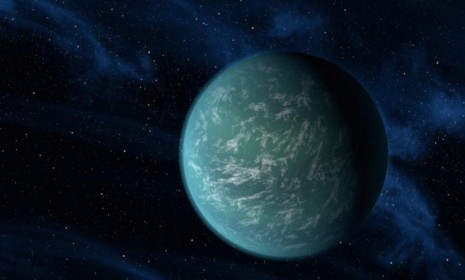Discovered: The first habitable 'Earth-like' planet
NASA's Kepler telescope makes a startling, exciting find: An alien world eerily similar to our own, right down to the pleasant summer temperature

Say hello to "Earth 2.0." NASA's planet-hunting Kepler spacecraft has discovered an alien world that might just support life as we know it. Here's what you need to know about Earth's new celestial cousin, Kepler-22b:
What exactly is the Kepler mission?
The Kepler spacecraft, which launched in 2009, is studying part of our neighborhood in the Milky Way Galaxy to see if there are any Earth-size planets within their own solar system's "habitable zone," meaning the planet orbits its star at a distance that could create conditions suitable to host life as we know it. Kepler is constantly monitoring the brightness of more than 100,000 stars. Based on fluctuations in brightness, scientists here on Earth crunch the numbers to see if there are planets orbiting those stars, and if they are within the "habitable zone."
The Week
Escape your echo chamber. Get the facts behind the news, plus analysis from multiple perspectives.

Sign up for The Week's Free Newsletters
From our morning news briefing to a weekly Good News Newsletter, get the best of The Week delivered directly to your inbox.
From our morning news briefing to a weekly Good News Newsletter, get the best of The Week delivered directly to your inbox.
Why are scientists so excited about this new planet?
It's the first planet confirmed by Kepler that could "conceivably harbor life," says Mike Wall at Space.com. That confirmation is key. Kepler has already found 2,326 "potential planets," which "would quadruple the current tally of worlds known beyond our solar system." Out of those potential planets, about 54 are in the habitable zone, and 68 are "roughly Earth-size." As scientists sift through heaps of data, Kepler-22b is the first to officially be confirmed.
And what makes Kepler-22b so special?
The "Earth-like" planet is 2.4 times larger than Earth and orbits its star much as our planet orbits the sun. Kepler-22b's calendar year takes 290 days. The planet boasts a "balmy temperature" of 72 degrees, which "would support the existence of liquid water," says BBC News. Kepler-22b gets about 25 percent less sunlight than Earth.
A free daily email with the biggest news stories of the day – and the best features from TheWeek.com
Great! So when do we move there?
Not so fast — Kepler-22b is 600 light years away from Earth. So, says Kara Swisher at All Things D, "if any geek is planning a star trek, it will take a lot of rocket fuel."
Sources: All Things D, BBC News, Space.com
-
 Why is Trump’s alleged strike on Venezuela shrouded in so much secrecy?
Why is Trump’s alleged strike on Venezuela shrouded in so much secrecy?TODAY'S BIG QUESTION Trump’s comments have raised more questions than answers about what his administration is doing in the Southern Hemisphere
-
 Vance’s ‘next move will reveal whether the conservative movement can move past Trump’
Vance’s ‘next move will reveal whether the conservative movement can move past Trump’Instant Opinion Opinion, comment and editorials of the day
-
 Why recognizing Somaliland is so risky for Israel
Why recognizing Somaliland is so risky for IsraelTHE EXPLAINER By wading into one of North Africa’s most fraught political schisms, the Netanyahu government risks further international isolation